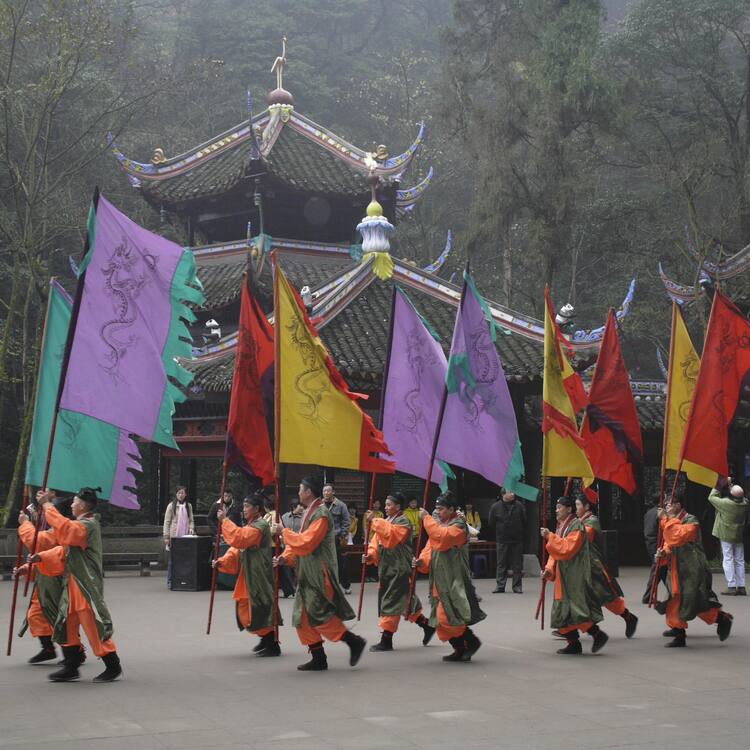Mount Qingcheng and the Dujiangyan Irrigation System
Mount Qingcheng and the Dujiangyan Irrigation System
Construction of the Dujiangyan irrigation system began in the 3rd century B.C. This system still controls the waters of the Minjiang River and distributes it to the fertile farmland of the Chengdu plains. Mount Qingcheng was the birthplace of Taoism, which is celebrated in a series of ancient temples.
Description is available under license CC-BY-SA IGO 3.0
Mont Qingcheng et système d’irrigation de Dujiangyan
La construction du système d'irrigation de Dujiangyan a commencé au IIIe siècle av. J.-C. Le système continue de réguler les eaux de la rivière Minjiang et de les distribuer sur les terres fertiles des plaines de Chengdu. Le Mont Qingcheng est le berceau du taoïsme qui est célébré par une série de temples anciens.
Description is available under license CC-BY-SA IGO 3.0
جبل كينشينغ ونظام دوجيانغان للريّ
بدأ بناء نظام دوجيانغان للري في القرن الثالث ق.م. وهو لا زال ينظم دفق مياه نهر مينجيانغ ويوزّعها على أراضي سهول شينغدو الخصبة. وجبل كينشينغ هو مهد الطاويّة التي يُحتفى بها بوجود سلسلة من المعابد القديمة.
source: UNESCO/CPE
Description is available under license CC-BY-SA IGO 3.0
青城山—都江堰
都江堰灌溉系统始建于公元前3世纪,至今仍控制着岷江的水流,灌溉着成都平原肥沃的农田。青城山是中国道教的发源地,因许多古庙著称。
source: UNESCO/CPE
Description is available under license CC-BY-SA IGO 3.0
Гора Цинчэншань и древняя оросительная система Дуцзянъянь
Строительство оросительной системы Дуцзянъянь началось в III в. до н.э. Она до сих пор регулирует воды реки Миньцзян и распределяет ее по плодородным угодьям равнины Чэнду. Гора Цинчэншань была местом зарождения даосизма, что отмечено несколькими старинными храмами.
source: UNESCO/CPE
Description is available under license CC-BY-SA IGO 3.0
Monte Qingcheng y sistema de irrigación de Dujiangyan
La construcción del sistema de regadío de Dujiangyan comenzó en el siglo III a.C., pero todavía sigue regulando las aguas del río Minjiang y distribuyéndolas por las fértiles llanuras de Chengdu. El Monte Qingcheng es la cuna del taoísmo y posee toda una serie de templos antiguos que conmemoran el nacimiento de esta doctrina.
source: UNESCO/CPE
Description is available under license CC-BY-SA IGO 3.0
青城山と都江堰水利(灌漑)施設
都江堰の灌漑設備の建設は紀元前3世紀に始まり、現在も岷江(ミンジャン)の水流を管理しており、成都(チャンドゥ)平原の肥沃な農地に水を供給している。青城山は老荘哲学(道教)の生誕の地であり、数々の寺院に祭られている。source: NFUAJ
Berg Qingcheng en het Dujiangyan irrigatiesysteem
De aanleg van het irrigatiesysteem van Dujiangyan begon in de 3e eeuw voor Christus onder leiding van Li Bing, magistraat van de Qin dynastie. Het Lidui gebied werd bewerkt, kanalen werden gegraven om overstroming tegen te gaan en om een weg voor het water te creëren zodat aangrenzende akkers geïrrigeerd zouden kunnen worden. Daarmee werd een 'land van overvloed' geschapen. Het water van de Minjiang rivier wordt tegenwoordig nog steeds door dit systeem gereguleerd. De berg Qingcheng was de geboorteplaats van het taoïsme – een van de meest invloedrijke religies van Oost-Azië in de geschiedenis – wat zich uit in talrijke oude tempels in het gebied.
Source: unesco.nl
Outstanding Universal Value
Brief synthesis
The Dujiangyan irrigation system, located in the western portion of the Chengdu flatlands at the junction between the Sichuan basin and the Qinghai-Tibet plateau, is an ecological engineering feat originally constructed around 256 BC. Modified and enlarged during the Tang, Song, Yuan and Ming dynasties, it uses natural topographic and hydrological features to solve problems of diverting water for irrigation, draining sediment, flood control, and flow control without the use of dams. Today the system comprises two parts: the Weir Works, located at an altitude of 726m, the highest point of the Chengdu plain 1km from Dujiangyan City, and the irrigated area. Three key components of the Weir Works control the water from the upper valley of the Minjiang River: the Yuzui Bypass Dike, the Feishayan Floodgate, and the Baopingkou Diversion Passage. Together with ancillary embankments and watercourses including the Baizhang Dike, the Erwang Temple Watercourse and the V-Shaped Dike, these structures ensure a regular supply of water to the Chengdu plains. The system has produced comprehensive benefits in flood control, irrigation, water transport and general water consumption. Begun over 2,250 years ago, it now irrigates 668,700 hectares of farmland.
Mount Qingcheng, dominating the Chengdu plains to the south of the Dujiangyan Irrigation System, is a mountain famous in Chinese history as the place where in 142 CE the philosopher Zhang Ling founded the doctrine of Chinese Taoism. Most of the essential elements of Taoism culture are embodied in the teachings of Taoism that emanated from the temples that were subsequently built on the mountain during the Jin and Tang dynasties. The mountain resumed its role as the intellectual and spiritual centre of Taoism in the 17th century. The eleven important Taoist temples on the mountain reflect the traditional architecture of western Sichuan and include the Erwang Temple, the Fulong Temple, the Changdao Temple built over the place where Zhang Ling preached his doctrines, and the Jianfu Palace (formerly the Zhangren Temple).
Criterion (ii): The Dujiangyan Irrigation System, begun in the 2nd century BCE, is a major landmark in the development of water management and technology, and is still discharging its functions perfectly.
Criterion (iv): The immense advances in science and technology achieved in ancient China are graphically illustrated by the Dujiangyan Irrigation System.
Criterion (vi): The temples of Mount Qingcheng are closely associated with the foundation of Taoism, one of the most influential religions of East Asia over a long period of history.
Integrity
Mount Qingcheng and the Dujiangyan Irrigation System have been completely preserved, with all necessary attributes demonstrating the outstanding universal value of the property included inside the property area and buffer zone. They express the importance of utilizing natural features to their fullest in constructing an irrigation system as well as Qingcheng Mountain's importance as one of the birth places of Tao ideology.
Authenticity
Dujiangyan Irrigation System is not only a living heritage of 2,000 year-old design and engineering ideas; it is also still in use today. The functions, religious traditions and the special religious status of the Taoist temple cluster of Mount Qingcheng are fully preserved while still maintaining traditional building styles. Furthermore, internationally accepted protection guidelines and rules have been adhered in conservation and repair projects in terms of location, design, materials, and techniques.
Protection and management requirements
Mount Qingcheng and the Dujiangyan Irrigation System were inscribed on the World Heritage List in 2000. It has also been declared a State Priority Protected Site, among the first batch of National Scenic Areas and Historical Sites, and a National ISO14000 Demonstration Area. Mount Qingcheng and the Dujiangyan Irrigation System are protected by several national laws including the Law of the People's Republic of China on the Protection of Cultural Relics; Environmental Protection Law of the People’s Republic of China, and Scenic Spots and Historical Sites Regulations. In addition to national laws, Sichuan Province has also enacted its own laws, including the Regulations on Conservation of Heritage of Sichuan Province and Regulations on Management of Scenic Spots and Historical Sites of Sichuan Province. The buffer zone of the property has been designated.
Currently, the conservation condition of both properties is excellent. During the Sichuan earthquake on May 12th, 2008, Dujiangyan Irrigation System was basically undamaged, but some Taoist shrines were damaged to varying degrees. Subsequently, these ancient structures were successfully repaired with the help of the State Administration of Cultural Heritage, Shanghai Municipal Government and the Macao Foundation. The Outstanding Universal Value of Mount Qingcheng and the Dujiangyan Irrigation System is kept through regular and rigorous maintenance and protection of the properties.

 View photos from OUR PLACE the World Heritage collection
View photos from OUR PLACE the World Heritage collection
